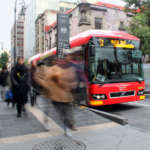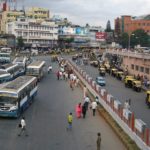Posts in the 'Integrated Transport' category
In the past few years, China has made eye-catching achievements in building the world’s largest high-speed rail system, with a total length of over 9000 km (5,600 miles) in operation in 2012. In China, trains travelling at design speeds above ...

Earlier this month, the government of São Paulo, Brazil, and METRÔ-SP published the results of the 2012 Mobility Survey. The data is heartening in many ways, for in a city where cars were once seen as symbols of wealth and ...

Recently Jeff Olson, co-founder of Alta Bicycle Share, took a moment to sit down for a discussion on bike-share and sustainable urban mobility with TheCityFix. Our discussion spanned Olson’s thirty years of work in the field and his thoughts on ...

South by South West (SXSW), the yearly festival that celebrates all things in entertainment technology, has just wrapped up in Austin, Texas. The festival featured many cool and innovative new devices – like virtual reality goggles, a computer that doubles ...

Turkey has had good fortune in seeing the personal incomes of its citizens rise from US$ 6,800 in 2000 to US$ 14,700 in 2011. Yet with increasing incomes has come a trend towards personal motorization, with private vehicle ownership jumping from 889,000 to ...

Planning an integrated transport network that moves people through cities quickly and efficiently is pivotal for cities to enable sustainable mobility. Few understand just how to difficult this can be, but the new Mini Metro game made by Dinosaur Polo ...

Belo Horizonte, one of the host cities for Brazil’s 2014 World Cup, is using its newfound spotlight to showcase its growing transport system. The city launched its MOVE bus rapid transit (BRT) system this past Saturday, March 8, 2014, which ...

The World Bank and EMBARQ Mexico are holding the second edition of the “Building Leaders in Transport Planning” training course for Mexico (#LUTPMx14). The course provides tools for systematic planning of integrated mobility corridor management, alternative public transport planning, evaluating ...

For those who live in or visit Brazil’s cities, it is not hard to see the effects of increasing motorization and car usage on our urban centers. Too many cities have become crippled by bottlenecks and stifling traffic congestion. Increased ...

Transport and urban planners spend much of their time thinking about distance to stations, fare pricing, and the key components that make sustainable transport systems work at a basic level, but they sometimes forget the smaller details that make transport ...

Population growth and rapid urbanization are combining to create huge challenges for Indian cities. According to McKinsey, Indian cities are expected to grow from 340 million people in 2008 to a whopping 590 million in 2030. Meeting demand for urban services ...

In developed cities, new mobility options typically only penetrate the transport ecosystem after governing bodies have developed an institutional framework around the new technology. Emerging economies, however, do not always have the regulatory capacity to standardize regulations and create policy ...

Less than ten years ago Lyon, France launched the first successful, modern bike-share system. Less than seven years ago Paris, France put bike-sharing in the global spotlight. Bike-sharing is no longer a novel experiment but a proven mobility solution. From ...

On the heels of Google recently releasing its new version of Google Maps – complete with contextual information based on past Google searches, different transport options with real-time traffic notifications, and panoramic photo tours – it’s hard to remember what ...

This is the tenth and final post of the “Sustainable Urban Transport On The Move” blog series, exclusive to TheCityFix. Preparation of this series was possible thanks to a grant by Shell Corporation. Its contents are the sole responsibility of ...

Page 29 of 135« First...1020...282930...4050...Last »






















